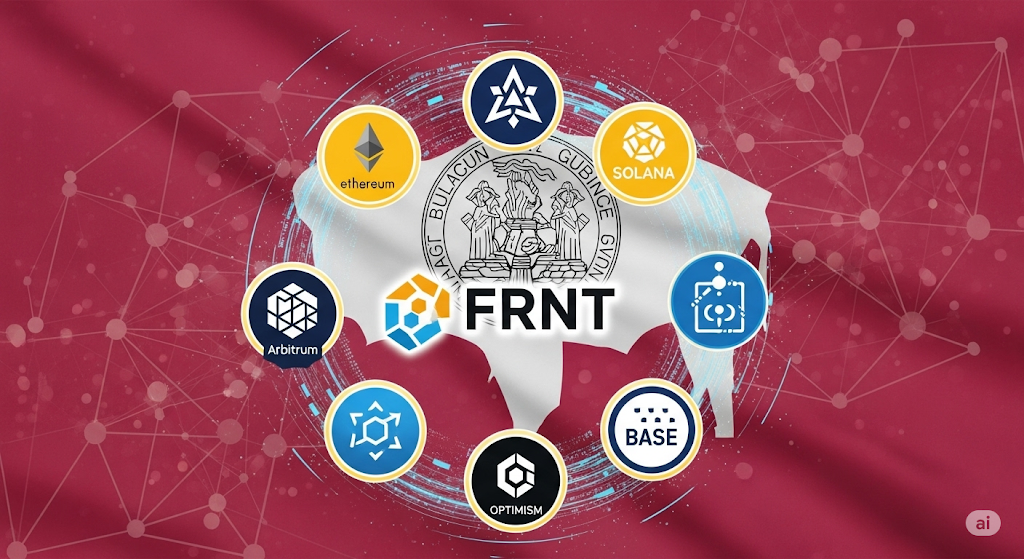Wyoming Makes History: First State-Backed Stablecoin FRNT Goes Live
Wyoming launches FRNT, America's first state-backed stablecoin, on 7 blockchains. This historic move could reshape state finance & accelerate crypto adoption nationwide. Backed by US Treasuries, FRNT enables instant government payments & Visa compatibility. A game-changer for digital assets!

Wyoming has officially launched the Frontier Stable Token (FRNT), becoming the first U.S. state to issue a government-backed stablecoin. This groundbreaking development marks a significant milestone in American digital asset adoption and could set a precedent for other states to follow.
Revolutionary State-Led Financial Innovation
The Frontier Stable Token (FRNT) went live on seven major blockchains: Arbitrum, Avalanche, Base, Ethereum, Optimism, Polygon, and Solana. Unlike traditional stablecoins issued by private companies, FRNT represents the first state-backed token issued in the U.S., backed by cash and U.S. Treasuries with interest generated by FRNT's reserves diverted to Wyoming's School Foundation Fund on a quarterly basis.
Mark Gordon, Wyoming's Governor and Chairman of the Wyoming Stable Token Commission, announced the launch at the Wyoming Blockchain Symposium in Jackson Hole. "This launch gives our citizens a modern, efficient, and secure way to transact," Gordon stated, calling it a milestone in Wyoming's journey to embrace financial technology.
The timing of FRNT's launch is particularly significant. The move comes about one month after President Donald Trump signed the first federal stablecoin bill into law, creating a framework for issuers to operate in the country through the GENIUS Act (Guiding and Establishing National Innovation for U.S. Stablecoins).
Technical Infrastructure and Safety Features
The Frontier Stable Token is designed to be 2% over-collateralized, backed by dollars and short-term Treasuries, and meant to track the value of the US currency one-for-one. The Wyoming Stable Token Commission is working with LayerZero to issue the tokens, with reserves managed by Franklin Advisers and financial audit and monthly attestations provided by The Network Firm.
According to an announcement shared by Avalanche developer Ava Labs, Wyoming's FRNT stablecoin will be available for use anywhere Visa is accepted through partnerships with financial technology companies. The Wyoming stablecoin will be available for purchase on the Solana network through the state's domiciled crypto exchange, Kraken, in the coming days, and investors can also purchase it through Rain's Visa-integrated card platform on the Avalanche network.
The state has already demonstrated FRNT's practical utility. Wyoming piloted FRNT stablecoin for real-time contractor payments, witnessing a notable reduction in timelines from 45 days to seconds, showcasing the potential for government payment system modernization.
Market Context and Regulatory Framework
The total USD-pegged stablecoin supply sits at around $265 billion, representing a massive and rapidly growing market. Stablecoins could become a trillion dollar market in the next few years and disrupt payments flows as adoption in the real economy expands, according to crypto trading firm Keyrock.
The launch operates under the newly enacted GENIUS Act framework. The GENIUS Act requires 100% reserve backing with liquid assets like U.S. dollars or short-term Treasuries and requires issuers to make monthly, public disclosures of the composition of reserves. This federal legislation provides the regulatory clarity that has enabled Wyoming's innovative approach.
FRNT is unique because it's not regulated under the GENIUS Act since Wyoming is a sovereignty—not a business, giving the state certain constitutional protections and obligations that private issuers don't have.
XRP/Ripple Analysis: Implications for the Ecosystem
The launch of Wyoming's FRNT has significant implications for the broader cryptocurrency ecosystem, including XRP and Ripple's business operations.
Competitive Landscape Impact: Experts such as Ripple CEO Brad Garlinghouse expected the stablecoin market could grow to a $5 trillion market, and this move at the state level by Wyoming could invite other U.S. states to replicate it. This presents both opportunities and challenges for Ripple's stablecoin ambitions.
XRP Ledger Exclusion Controversy: Cardano founder Charles Hoskinson argued that XRP was excluded from Wyoming's stablecoin selection process, stating "XRP was a huge loser in this biased process" and noting that if Ripple had been allowed to participate, "Wyoming could have issued millions of dollars in tokens using the RLUSD infrastructure". This controversy highlights potential missed opportunities for XRP ecosystem growth.
Market Dynamics: Ripple CEO Brad Garlinghouse has positioned stablecoins as complementary to XRP's role as a bridge currency, stating "I see stablecoins as a complement or even an accelerant to what Ripple's doing at its core". Wyoming's success could validate this multi-asset approach to cross-border payments.
RLUSD Competition: With Ripple recently launching its own RLUSD stablecoin, Wyoming's FRNT represents state-level competition that could influence regulatory approaches to stablecoin adoption. The success of FRNT might encourage other states to develop their own solutions rather than adopt private alternatives like RLUSD.
Adoption Implications: XRP currently trades at $3.08 with a market cap of $183.3 billion, and state-backed stablecoin adoption could either compete with or complement XRP's utility depending on implementation approaches by other states.
Looking Forward: The Future of State Digital Currencies
Flavia Naves, a commissioner at the Wyoming Stable Token Commission, indicated this is just the beginning: "Down the road, the intent is to utilize the same technology … to enable other elements to turn into tokens and be on blockchains, whether it is commodities such as gold or oil, whether it is real estate, other governmental obligations".
Wyoming's pioneering approach could inspire other states to develop their own digital currencies, potentially creating a decentralized network of state-backed tokens. This development represents a fundamental shift in how states approach financial technology and could accelerate mainstream cryptocurrency adoption.
The successful launch of FRNT demonstrates that state governments can effectively navigate the complex regulatory landscape while delivering innovative financial solutions to their citizens. As the first of its kind, Wyoming's stablecoin will likely serve as a crucial case study for other states considering similar initiatives.
Key Takeaways: Wyoming's FRNT launch represents a historic moment in American cryptocurrency adoption, combining state sovereignty with cutting-edge blockchain technology. The project's success could reshape how governments approach digital currencies and accelerate the integration of blockchain technology into public financial systems.
DISCLAIMER: This newsletter is for informational purposes only and does not constitute investment advice or a recommendation to buy, sell, or hold any securities. Investments in cryptocurrencies or other financial assets carry significant risks, including the potential for total loss, extreme volatility, and regulatory uncertainty. Past performance is not indicative of future results. Always consult a qualified financial professional and conduct thorough research before making any investment decisions.
Sources
- The Block - Wyoming launches first state-backed stablecoin on seven blockchains
- Bloomberg - Wyoming Becomes the First to Launch a State-Issued Stablecoin
- Yahoo Finance - Wyoming's 'Frontier' Stablecoin Debuts on Ethereum, Solana and Avalanche
- Cointelegraph - Wyoming launches Visa-supported FRNT stablecoin on 7 blockchains
- White House Fact Sheet - President Donald J. Trump Signs GENIUS Act into Law
- TheCryptoBasic - Why Cardano Founder Insists XRP Lost Big in the Wyoming Stablecoin Saga
- Ledger Insights - Why Ripple's stablecoin launch makes sense
- CoinDesk - Wyoming State Debuts U.S. Dollar Stablecoin on Seven Blockchains



